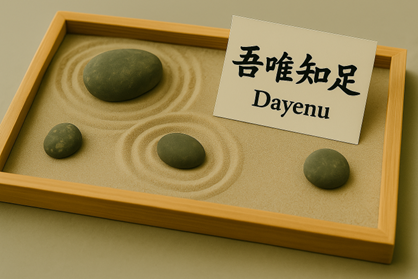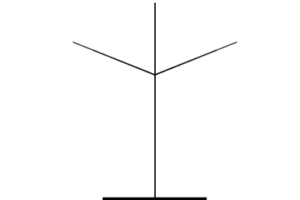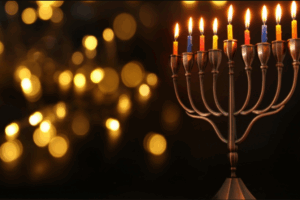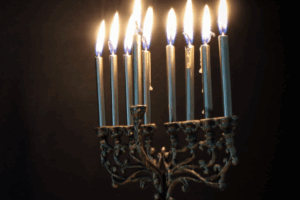Fourteen stones in view
the fifteenth waits in stillness,
afikoman heart.
Our family loves Japan.
“日本語が大好きですね.” (I really love Japanese!) Lucy texted me that the other day. A minute later came another message in English: “I just spent so much time talking in Japanese. It was lit!”
I wrote back:
「ルーシーが日本語を好きなのは、ご飯の白さみたいに当たり前だね。」
(Your love of Japanese is as natural as white on rice.)
That’s a typical exchange between my favorite younger daughter, Lucy, and me. She tells me how much she loves Japanese; I beam with pride at her determination and proficiency. Lucy and I even shared the same first-year Japanese teacher at Harvard. When I arrived, Kageyama-sensei was the youngest instructor. Years later, when Lucy was a freshman, she had become department chair. Time braided our lives in a very Japanese way.
Over a recent lunch, a new friend who had also lived in Japan asked a simple question: we’re both Jewish and infatuated with Japan, what connects the two? Until that moment, I hadn’t tried to name the bridge.
I lived in Japan in high school, in Hanazono-ku in northwest Kyoto, with the generous Kitamaru family. Ryoan-ji was nearby. The first time I entered its rock garden, I felt quietly transported. There are fifteen stones, but from any vantage you can see only fourteen. The fifteenth is hidden. Zen teaches it’s felt in the heart.
Years later I took Caroline and Lucy to Japan for a summer when they were thirteen and ten. They studied in a local school and something in Lucy lit up. That seed later blossomed in college Japanese and today she texts me in nihongo for fun.
Two ideas, one from each tradition, keep interplaying in my mind. The first is gratitude. Near Ryoan-ji’s garden stands a small stone basin, a tsukubai. Its inscription reads 吾唯知足: ware tada taru o shiru: “I only know contentment.” Dayenu in another language. At our Passover table, Dayenu is a family favorite. We even play with small gratitude game: “If we had only this delicious dinner with Caroline and Lucy, and not the rest of our friends and family—Dayenu.” Given Breaking Matzo’s tradition of many international charoset recipes, “If we had only one kind of charoset, and not eleven—Dayenu.” The formula trains the heart to notice “enough” before “more.” The hidden fifteenth stone and the Seder’s afikoman feel like cousins. Something precious and deliberately concealed which reminds us that a hidden piece of ourselves completes the story. You can read more about Dayenu here.
The second idea is time. In tea culture there is ichigo ichie—一期一会—“one time, one meeting.” Each encounter is unrepeatable. Years ago, I gave Lucy a calligraphy of this saying and she still treasures it today. Ichigo ichie is the foundation of omotenashi; Japanese hospitality, an anticipatory welcome that treats this guest, this cup, and this breath as singular. Judaism answers with Rabbi Abraham Joshua Heschel’s “palace in time.” Shabbat arrives every week for twenty-four hours, independent of place. Our holy days live on the calendar, not in a building. We celebrate anywhere: at home, on the road, even davening in the desert. Only Sukkot asks for a place; a fragile hut beneath the sky, precisely to remind us that place, too, is temporary while time remains holy. You can read more about Rabbi Heschel here.
Order is central in both Japan and Judaism. Japan orders life by place: the bento’s compartments, elevator etiquette, and the meeting’s seating chart. Judaism orders life by process: Seder literally means “order”: blessings, washings, telling, tasting, remembering.
Leadership is structured differently in each culture as well. In Japan, deference flows to age and rank. In Judaism, the youngest asks the Four Questions and a thirteen-year-old bar or bat mitzvah can deliver a d’var Torah.
Even our washings share purpose while diverging in rhythm. At Ryoan-ji’s tsukubai, you purify your own hands and pray quietly, often alone. In Jewish life, the Levites wash the hands of the Kohanim and; at the Seder we wash twice, and we often pray with a minyan-not because
God can’t hear us solo, but-because community is part of the prayer.
A recall a small scene from my time in Japan: a tea host bowed, hands low. Steam rose from a small chawan. Mr. Mogi and Lucy spoke in quick Japanese; I sat in quiet gratitude. I mouthed “Dayenu” as the first sip touched my lips, enough, right here.
Why does this matter? Because I realized how long I kept these loves in separate silos. Japan in one reservoir, Judaism in another, not letting them irrigate each other. The moment I let the waters mingle, curiosity began to flow again. No new facts, just new awareness. Jacob’s ladder (Genesis 28) comes to mind: angels going up and down on the same rungs. My up-and-down years, Japan and Judaism, share one ladder. The Torah teaches integration over compartmentalization. The Ark is overlaid with gold inside and out. Wholeness is holy; not celebrated separateness.
And this learning doesn’t end in me. On our first visit to Ryoan-ji, Lucy was ten, chattering in front of the stone garden and distracted by the heat. On our last trip, it was a joy to walk Japan with her language and cultural fluency lighting the way. Back at Ryoan-ji, she settled into the stillness of the inner stone sanctum and met her own quiet. Around the corner she discovered the tsukubai and, smiling, performed the solitary cleansing. Her growth in Japan was palpable. With Caroline and Quincy’s wedding and, God willing, future generations of Goldfarbs around our Seder table, I can imagine teaching the next generation both the ichigo ichie of the present moment and the Dayenu of enoughness.
A small practice, if you’d like to try it this week: before lighting candles, whisper ichigo ichie; one time, one meeting, to honor this unrepeatable Shabbat. After Kiddush, offer one personal Dayenu line: “If I had ______ and not ______—Dayenu.” One sentence is enough. Enough is the point.
Japan has been my mind; Judaism, my soul. From today, I will live them as one; inside and out. Dayenu.
Ladle: Dayenu
a palace made of set time,
once is everything.
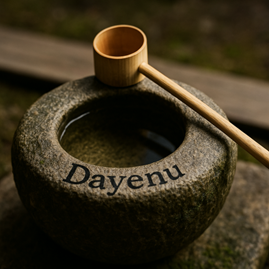
Postscript remembrance:
I remember fondly my Harvard professor Henry Rosovsky, who taught me Japanese economics and was a pioneer in forging relations between Jews, Israel, and Saudi Arabia in the early 1980s. Back then I saw these pursuits as separate and distinct. Now I see Henry’s life and work in a newly integrated light, fractured facts harmonized into a beautiful rainbow.
Further reading:
Tsukubai are stone water basins that are used in purification rituals and tea ceremonies. The zenibachi is a famous tsukubai located at the Ryoanji Temple in Kyoto. The zenibachi is shaped like an ancient Chinese coin. The round shape represents the Earth and the square cut into the center represents the heavens. There are four characters carved into it with the following meanings:
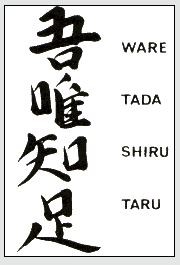
Together they translate to “I only know plenty”, a quote with a myriad of meanings and inspirations. I interpret it to mean “I am content with what I have”, a spiritual parallel to the Hebrew Dayenu: “It would have been enough.” I am filled with joy each time I see this unique and meaningful structure. You can learn more about the zenibachi here.
You can read more about Ryoanji and Japanese hospitality of Omotenashi here and here.
You can read about Heschel’s Temple of Time here and more about Dayenu here.
You can read about the Fugu Plan and the connections between Japan and Jews in World War II here.
Exodus 25:11; Holy Wholeness, not celebrated separateness
Hebrew:
וְצִפִּיתָ אֹתוֹ זָהָב טָהוֹר; מִבַּיִת וּמִחוּץ תְּצַפֶּנּוּ, וְעָשִׂיתָ עָלָיו זֵר זָהָב סָבִיב.
Translation (literal):
“You shall overlay it with pure gold; inside and outside you shall overlay it, and you shall make upon it a rim of gold all around.”

